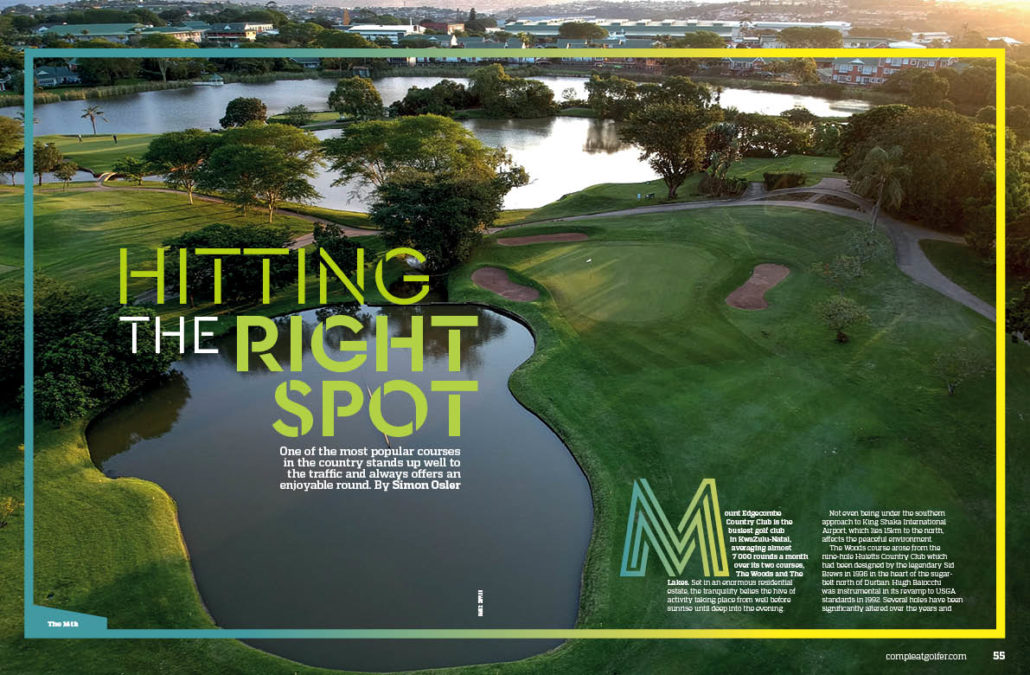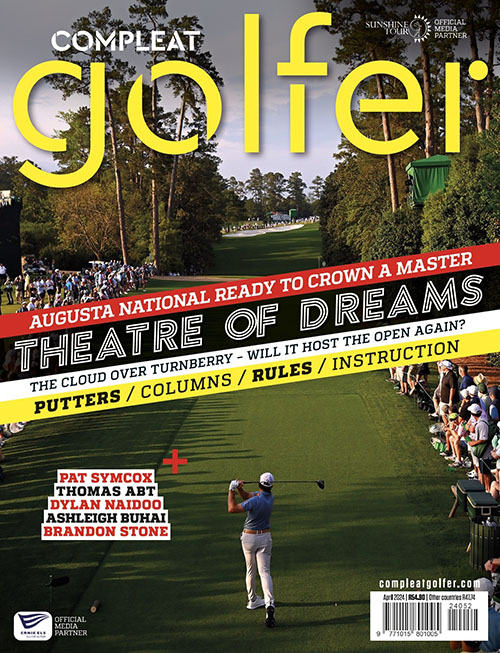Mount Edgecombe Country Club, one of the most popular courses in the country, stands up well to the traffic and always offers an enjoyable round, writes SIMON OSLER.
Mt Edgecombe is the busiest golf club in KwaZulu-Natal, averaging almost 7 000 rounds a month over its two courses, The Woods and The Lakes. Set in an enormous residential estate, the tranquility belies the hive of activity taking place from well before sunrise until deep into the evening.
Not even being under the southern approach to King Shaka International Airport, which lies 15km to the north, affects the peaceful environment.
The Woods course arose from the nine-hole Huletts Country Club which had been designed by the legendary Sid Brews in 1936 in the heart of the sugar-belt north of Durban. Hugh Baiocchi was instrumental in its revamp to USGA standards in 1992. Several holes have been significantly altered over the years and recently a re-routing of some of the holes has changed the flow of play substantially.
The old course has played host to the Nelson Mandela Challenge, co-sanctioned by the European Tour and the Sunshine Tour, while the R1-million Sibaya Challenge tends to alternate between the two courses. The Woods has also entertained many a top amateur when it has staged the SA Amateur Match Play Championship.
With five par threes and three par fives, the par-70 course is 5 885m from the back tees, a little on the short side when pitted against the modern technological weaponry the top young guns possess these days. It’s no surprise to find that the course record is a 61 posted by relatively unknown Breyten Meyer on his way to second place at the Sibaya Challenge last year (and that included a bogey at the 2nd).
The 1st hole is a gentle downhill par four that runs from east to west and is usually assisted by the easterly sea breezes. Beware the tree that hangs over the left portion of the rather narrow fairway about 140m out or you could find yourself having to play out sideways and still having a full wedge to the raised and elongated green.
Make an about-turn and head back into the prevailing wind for the longest of the par threes, at 193m and slightly uphill. Being one club short here isn’t the worst play if you are a straight hitter as there’s a generous space to approach the green, which slopes from back to front.
Having played two holes where the trees shouldn’t really be in play, the 3rd hole takes you through an avenue of wood … and at 510m this par five will require your full attention. Visually it is an intimidating tee shot, but running out of fairway either side at driving distance is not a train smash. Play it as a three-shotter to reach the green and it’s easier to see why the hole’s stroke index is a lowly 16.
The 4th hole is guarded by a tree at around 200m which blocks the left half of the fairway. Quite steeply uphill and seemingly always into the breeze, and with out-of-bounds on the right, club selection – particularly for the second shot – is key to grinding out par on one of the tougher holes. You don’t want to be on the wrong level on the two-tiered green either.
The 5th hole is a fairly unmemorable par five which does offer some birdie opportunities, but the par-four 6th is where the big hitters and tactical players can think about some scoring opportunities. At 267m up the hill, the big hitters can either knock it on to the green or into the big bunker guarding the width of the green. For the shorter hitters, a 5-iron or hybrid, followed by a good wedge, can also lead to birdie chances.
Then on to the 7th, which over the years has probably been one of the most-changed holes in the country. It started off as a par five, was reduced to a par four, and is now a mid-length par three. Downhill, but into a swirling breeze, long and left is a definite no-no. Being a club short here is the ‘safe’ play if you want a comfortable par but you won’t ever get a hole-in-one by being conservative!
The 8th is not only one of the toughest holes on the course, it’s also one of the best. An accurate tee shot to about 120m from the front of the 35m-long, elevated and sloping green will leave a short- to mid-iron in. While there are houses and out-of-bounds on the left at driving distance, you don’t want to go too far right either. That will bring the woods into play, while right with your second shot will see you in the water or, if you clear that, in one of two bunkers well below the green.
A stone’s throw away is the 9th, a tough finish to the front nine. With an elevated tee, and playing slightly downhill and often downwind to a large green protected by water left and bunkers front right and back, precision is important here. Pick a club and trust it, hit it well and you may just get a round of applause from those in the halfway house or on the balconies at the clubhouse.
Believe it or not, you have come through the ‘easier’ nine. According to the latest SAGA stroke indices, the back nine is about one stroke tougher than the front. But at least it has three relatively easy holes to get you going again after replenishing the energy levels at the halfway house.
Easing back into action, the 10th hole is only 310m long – given the topography of the hole, a smart play would be 4-iron and a wedge. The 11th is only 20m longer and runs parallel, but in the opposite direction, to 10. Favour the right half of the fairway to take the trouble out of play. With 12 being the shortest hole on the course at 154m, it’s no surprise that it is well protected by bunkers, most of which are at the front
and right. Take the front bunkers out of play by selecting one club more and you will give yourself a birdie chance.
Hopefully you have cruised through these holes as you are now going to face five of the six toughest holes on the course.
The tee shot on 13 is along an avenue of trees but there is a generous fairway. The second shot plays about 20m uphill from around 140m out but you need to be playing this shot from the middle of the fairway or the trees short of the green on both sides may give you trouble.
Turning into ‘Amen Corner’ you begin with the longest of the par fives, the tough 14th. It may sound long at 521m but for the longer hitters there are several ‘speed slopes’ which will carry the ball down the significant drop in elevation. Water in front protects the green, which is probably the smallest on the course, so accuracy and precision are a must if you want a low score here. In fact, at the Sibaya Challenge last year, among the top-five finishers only winner Louis de Jager birdied the hole, with the next four on the leaderboard only able to record par. Its stroke rating of nine indicates just how tough this hole can play.
Next up, the signature hole, the 15th.
Having survived the 15th, you have no time to rest on your laurels, as the 16th is stroke one on the card. At 405m it’s not too long, but the more you try to cut the corner, the more you bring the big dam into play. If you can hit a draw, aim at the 150m marker in the distance, over the heads of the many pelicans that line the far bank of the dam. If your natural shot is a fade, aim a bit further left. Most players get a shot on this hole for a reason … take it and be grateful for your ‘5/2’ on the card.
Now you can unwind a bit, as the 17th is the easiest hole of the final six. A short par four to an elevated green, it’s not an easy birdie but definitely an easy par.
Your closing hole is no pushover, requiring an accurate tee shot and a crisp mid-iron, usually into the prevailing wind. Normally there are many red deer watching the action from among the trees off the right edge of the fairway, just beyond driving distance. A welcome distraction, but you aren’t finished your round yet. A large sloping green offering numerous tricky pin placements means a three-putt bogey is often on the cards. You need to get the pace just right to cement your closing hole. There’s also a little added pressure from the occasional spectator on the deck outside the pro shop who is watching your approach.
The Woods is a course which should be walked, although the club does offer carts, and many of the residents have their own carts too, easing the pressure on availability.
www.mountedgecombe.com







